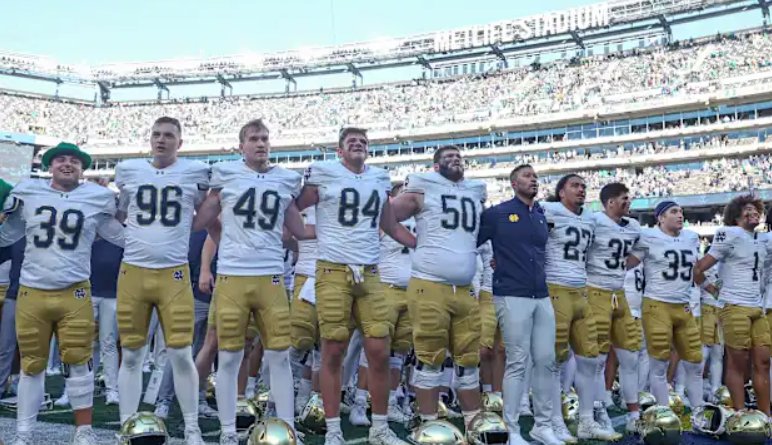Notre Dame Takes Massive Advantage of Navy’s Turnovers to Bolster College Football Résumé
After not giving up the ball since their first game and a streak of 307 consecutive plays, the Midshipmen’s six turnovers turned into their first loss of the season.
Unexpected success in college football can stem from various factors, but a common foundation often lies in a significant turnover margin advantage. Want to achieve a Cinderella season? Simply take the ball away more times than you give it up; it’s a straightforward route to victory.
This statistic, which emerges from a blend of opportunity and preparation, helps explain the surprising undefeated starts of teams like the Iowa State Cyclones (plus-nine turnover margin), Pittsburgh Panthers (plus-seven), Indiana Hoosiers (plus-eight), and BYU Cougars (plus-seven). It’s also relevant for the service academies, with the Army Black Knights sitting at plus-eight and the Navy Midshipmen entering Saturday’s game against the Notre Dame Fighting Irish with an impressive plus-12, the second-best in the nation.
The Midshipmen hadn’t turned the ball over since their opening game against Bucknell. Their inventive hybrid wing T/option offense operated with remarkable precision, with many moving parts functioning smoothly. They managed an incredible streak of 307 consecutive plays without a turnover from late in that first game through last week, marking an extraordinary commitment to disciplined football.
Throughout the season, the Navy Midshipmen emerged as one of the standout stories of 2024, turning this match into an unexpected spectacle. It was broadcast nationally on ABC in an NFL stadium, attracting a large crowd—an environment that Navy is not typically used to.
However, Navy’s biggest strength quickly became its greatest flaw. After five games without any turnovers, the No. 24-ranked Midshipmen struggled in the Meadowlands, losing five fumbles and throwing an interception in a 51–14 setback against Notre Dame. The six turnovers marked the highest for the program since 2002.
The numerous fumbles were particularly disheartening as they were unforced by the opposing defense: a simple pitch to fullback Alex Tecza was dropped; a mishandled handoff left the ball available for the taking; a muffed punt by Isaiah Bryant did the same; quarterback Blake Horvath, enjoying a strong season, lost control of the ball in the end zone, allowing the Irish to recover for a touchdown; and Eli Heidenreich also fumbled another punt.
“When you look at almost every turnover or fumble, it was something we did,” Horvath said. “They barely had to touch the ball. We wanted it so badly, but we shot ourselves in the foot.”
In maritime terms, this situation was akin to the Exxon Valdez running aground in Alaska. The game was effectively over in time for Bill Belichick—who grew up in Annapolis while his father Steve was an assistant coach at Navy—to leave the stadium early.
“I thought the stage might have been a little too big for our players today,” Navy coach Brian Newberry admitted. “There were a lot of mistakes. We had players afraid to make errors. When you play with that kind of fear, you end up making mistakes.”
Thus, Navy’s perfect 6–0 start crashed into a much stronger opponent. The Irish were quick to capitalize on the mistakes, turning the Midshipmen’s errors into easy points and a comfortable win—enhancing their 7–1 College Football Playoff resume.
Looking to strengthen their standing, Notre Dame entered the second half of the season needing solid wins. While their opening victory over Texas A&M has gained significance, other results haven’t resonated as much, particularly a disappointing loss to Northern Illinois in Week 2. With Florida State struggling and USC faltering in its first Big Ten season, the Irish had few quality opponents.
Just in time, Army and Navy both managed to start the season 6–0 simultaneously for the first time since 1926, with Army now at 7–0 but facing two more games before meeting the Irish on November 23. This game against Navy was an opportunity for the Irish.
If the moment was overwhelming for the Midshipmen, it was perfect for the Irish. They struck fast, scoring on their opening drive and converting Navy’s first fumble into another touchdown to take a 14–0 lead. They amassed 466 yards of offense, executing several big plays, and did not commit any turnovers themselves.
The only game this season where Notre Dame lost the turnover battle was the disappointing matchup against Northern Illinois, where the Irish finished minus-two. It was evident that the team hadn’t fully moved on from their victory at Texas A&M earlier in the season, a painful lesson that coach Marcus Freeman wants to keep at the forefront of his players’ minds.
“We can’t forget the pain,” Freeman stated. “I don’t want us to lose sight of that experience. It motivates us. I sometimes have to remind them of that pain. We’ll use it and be thankful for it.”
Now, Notre Dame will become Navy’s biggest supporters—the more wins the Middies achieve, the better Notre Dame’s performance will look. Additionally, the two schools share a long history of mutual respect, which is reflected in the way players and coaches from both sides stood together for their respective alma maters after the game.
The Navy played a crucial role in keeping Notre Dame viable as a university during and right after World War II. During Father Theodore Hesburgh’s 35 years as president, he stated that the football series would continue as long as Navy desired it. This matchup marked their 97th meeting, making it the most-played rivalry in Fighting Irish history.
This could be the first Navy game in a long time that positively impacts Notre Dame’s national standing. The CFP selection committee will consider the strengths of the Midshipmen as well as their tendency to self-destruct during this game. While a 51-14 win over a ranked opponent looks impressive, the plus-six turnover margin—largely a result of mistakes from the opposing team—reveals a significant part of the story.
